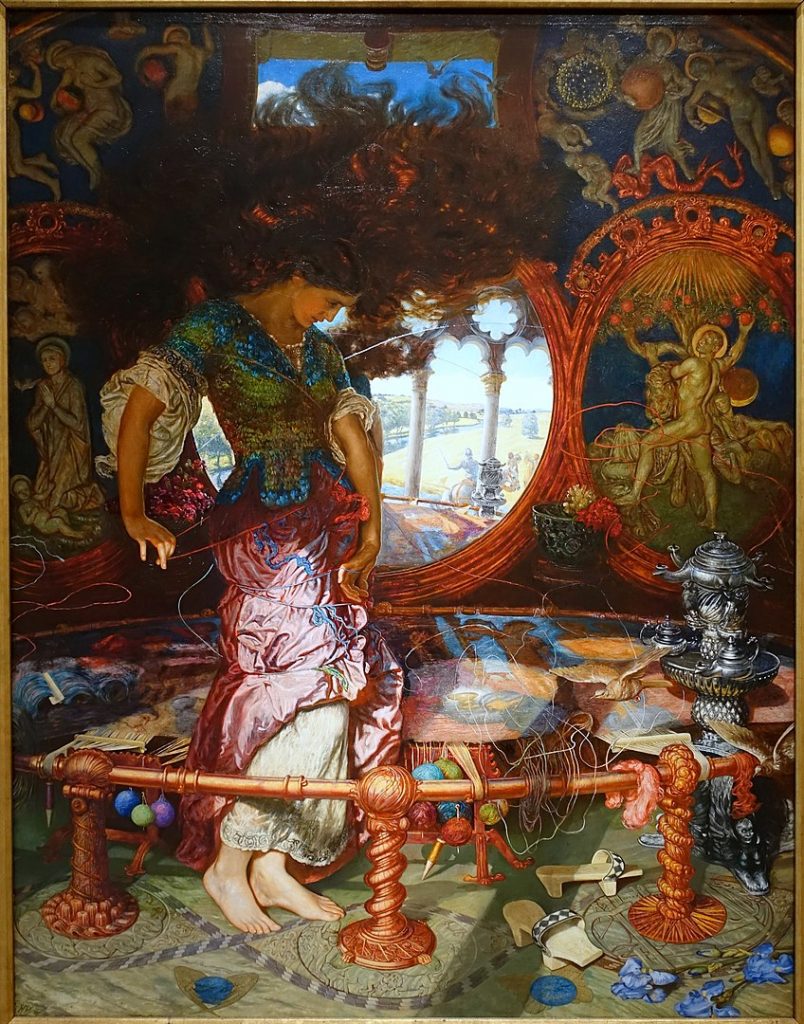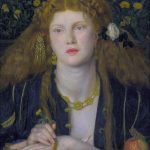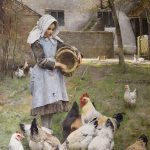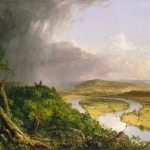
The Pre-Raphaelite Brotherhood, founded in 1848 in England, marked a turning point in the history of art. A group of seven young artists, led by Dante Gabriel Rossetti, John Everett Millais, and William Holman Hunt, sought to rebel against the rigid conventions of academic art. Their vision was to recapture the brilliance and detail of art before the High Renaissance, drawing inspiration from the early works of Raphael. This revolutionary movement combined a reverence for nature, an embrace of symbolism, and an intense focus on emotional authenticity.
During the mid-19th century, the Victorian art scene was dominated by traditional ideals promoted by institutions like the Royal Academy. The Brotherhood aimed to challenge these norms, offering a fresh perspective that highlighted individual creativity and unmediated observation of nature. The name “Pre-Raphaelite” symbolized their aspiration to restore the purity and vitality they believed had been lost in art after Raphael. Their work stood in stark contrast to the formulaic and mechanical techniques taught in academic circles.
At the heart of the Brotherhood’s mission was a desire to elevate art as a moral and spiritual endeavor. They believed in the integration of literature and art, drawing from poets like Shakespeare, Tennyson, and Dante Alighieri for inspiration. Their early works embodied these ideals, combining vibrant colors, intricate details, and themes steeped in medievalism. By doing so, they sought to bridge the gap between artistic tradition and innovation.
Despite their idealism, the Pre-Raphaelites faced significant challenges in gaining recognition. The Victorian public, initially skeptical, viewed their art as unconventional and even scandalous. However, their persistence and groundbreaking approach eventually paved the way for widespread appreciation, leaving an indelible mark on art history. Their founding not only revolutionized aesthetics but also ignited a cultural movement that resonated far beyond their era.
Founding Members and Key Figures
Dante Gabriel Rossetti, one of the most influential members, was born in 1828 in London. His Italian heritage and literary upbringing profoundly shaped his artistic and poetic sensibilities. Rossetti’s charisma and visionary ideas made him a natural leader within the Brotherhood. His relationship with Elizabeth Siddal, a fellow artist and muse, added depth to his work, particularly through her depictions in paintings like Beata Beatrix, which symbolized love and loss.
John Everett Millais, born in 1829, was celebrated as a prodigy and the youngest artist ever admitted to the Royal Academy Schools. His technical mastery and innovative use of color and light set a new standard in Victorian painting. Millais’ work, such as Ophelia, exemplifies the Brotherhood’s ideals through its meticulous attention to natural details and emotional resonance. Over time, however, Millais shifted toward more commercial and mainstream art, leaving a complex legacy within the movement.
William Holman Hunt, born in 1827, was deeply committed to the moral and religious themes that characterized much of the Brotherhood’s work. His dedication to realism and symbolism is evident in masterpieces like The Light of the World, a deeply spiritual painting that gained widespread acclaim. Hunt’s unwavering focus on spiritual themes set him apart from his peers, emphasizing his belief in art as a tool for moral instruction.
Other significant figures included Ford Madox Brown, Edward Burne-Jones, and William Morris, who contributed to the broader Pre-Raphaelite ethos. These artists, though not founding members, expanded the movement’s influence, particularly in areas like design and literature. The muses of the Brotherhood, including Elizabeth Siddal and Jane Morris, played vital roles as collaborators and inspirations, embodying the movement’s ideal of beauty and grace.
While the founding members—Dante Gabriel Rossetti, John Everett Millais, Frederic George Stephens, James Collinson, Thomas Woolner, William Michael Rossetti, and William Holman Hunt—shaped the core of the Pre-Raphaelite Brotherhood, their influence extended to later generations of artists. One such figure was John William Waterhouse, who, though not a founding member, absorbed the Brotherhood’s ideals and brought them into the late 19th century. Waterhouse’s works, such as The Lady of Shalott and Hylas and the Nymphs, reflect the Pre-Raphaelite commitment to narrative depth, naturalism, and emotional resonance. By blending their principles with his distinct style, Waterhouse ensured that the Brotherhood’s vision remained relevant even as art transitioned into a new era.
Artistic Philosophy and Core Values
At the core of the Pre-Raphaelite Brotherhood’s philosophy was an unyielding commitment to truth and nature. They believed that art should faithfully reflect the natural world, free from the artificial conventions of academic training. This conviction led them to paint en plein air, capturing the subtle interplay of light, texture, and color in their work. By emphasizing naturalism, they sought to reconnect art with the authenticity and purity of early Renaissance masterpieces.
The Brotherhood rejected the mechanical techniques and formulas of the Royal Academy, which they felt stifled creativity. Instead, they embraced individuality and experimentation, creating works that were deeply personal and innovative. Literature played a central role in their artistic vision, with many of their paintings drawing from Shakespeare, Tennyson, and the Bible. These literary influences infused their work with narrative depth and symbolic complexity, bridging the gap between visual art and storytelling.
Medievalism was another defining characteristic of the Brotherhood’s aesthetic. They romanticized the simplicity and spirituality of medieval life, often incorporating Gothic architecture, religious iconography, and chivalric themes into their paintings. This medieval revival extended beyond art into their personal lives, influencing their fashion, homes, and social ideals. Through this, they sought to challenge the materialism and industrialization of their time, offering a countercultural vision rooted in beauty and meaning.
Symbolism was a hallmark of Pre-Raphaelite art, blending realism with allegory to convey complex emotions and ideas. Whether through the depiction of a single flower or the posture of a figure, every element in their work was imbued with meaning. This attention to detail not only elevated their art but also invited viewers to engage more deeply with its themes. The Brotherhood’s commitment to symbolism and narrative continues to inspire modern artists and audiences alike.
Iconic Works and Their Legacy
Among the Brotherhood’s most celebrated works is John Everett Millais’ Ophelia, painted between 1851 and 1852. This masterpiece captures the tragic Shakespearean heroine submerged in a lush river, surrounded by meticulously detailed flora. The painting’s vibrant colors and lifelike depiction of water and vegetation exemplify the Brotherhood’s dedication to realism. Millais’ use of Elizabeth Siddal as the model adds a poignant layer, intertwining art with the personal lives of its creators.
William Holman Hunt’s The Light of the World, completed in 1854, stands as a testament to the spiritual dimension of Pre-Raphaelite art. Depicting Christ holding a lantern and knocking on a door, the painting symbolizes the theme of spiritual awakening. Hunt’s intricate attention to detail, from the texture of Christ’s robe to the overgrown ivy on the door, underscores the Brotherhood’s philosophy of imbuing realism with deeper meaning. The painting’s reception was overwhelmingly positive, cementing Hunt’s reputation as a moralistic artist.
Dante Gabriel Rossetti’s The Blessed Damozel showcases his dual talents as a painter and poet. The painting, inspired by his poem of the same name, portrays a grieving woman gazing down from heaven, longing for her earthly lover. The rich colors, ethereal atmosphere, and emotional intensity of the work reflect Rossetti’s Romantic sensibilities. Through this piece, Rossetti established a bridge between visual and literary art, highlighting the interdisciplinary nature of the Brotherhood’s vision.
The Hireling Shepherd by Holman Hunt offers a critical lens on contemporary social issues, blending Pre-Raphaelite aesthetics with commentary. The painting depicts a shepherd neglecting his flock while engrossed in conversation, symbolizing moral decay and irresponsibility. Hunt’s intricate detailing of the natural setting underscores the Brotherhood’s emphasis on nature while reinforcing the allegorical power of the scene. Such works reveal the movement’s ability to balance beauty with social critique, making their art both timeless and relevant.
The Pre-Raphaelite movement’s legacy endured not only through its founding members but also through later artists like John William Waterhouse. His iconic painting The Lady of Shalott, inspired by Tennyson’s poem, echoes the Brotherhood’s love of literary themes and intricate detail. In works such as Hylas and the Nymphs, Waterhouse expanded on the Pre-Raphaelite fascination with symbolism and nature, incorporating a softer, dreamlike quality. These contributions underscore the lasting impact of the Brotherhood’s ideals, influencing artists far beyond its original timeframe.
Controversies and Criticism
The Pre-Raphaelite Brotherhood’s radical approach to art provoked a storm of criticism from the traditional art establishment. Critics from institutions like the Royal Academy dismissed their work as amateurish and overly sentimental. Early reviews often ridiculed their paintings for their vivid colors, detailed realism, and symbolic elements, which deviated starkly from Victorian artistic norms. Despite this backlash, the Brotherhood remained steadfast, viewing these critiques as confirmation of their revolutionary mission.
Accusations of excessive idealism and naivety also plagued the Brotherhood’s reputation. Some argued their medievalism was escapist, ignoring the industrial and social realities of 19th-century England. Paintings like The Hireling Shepherd, while deeply symbolic, were sometimes misunderstood as overly moralistic or disconnected from contemporary issues. This tension highlighted the gap between their artistic ideals and the expectations of the broader Victorian audience.
Internal conflicts among the Brotherhood’s members further complicated their legacy. As their careers evolved, members like John Everett Millais moved toward more commercially viable art, leading to perceptions of betrayal within the group. These divergences underscored the difficulty of maintaining a cohesive movement while balancing personal ambitions and artistic philosophies. Such struggles reflected the broader challenge of sustaining an avant-garde vision in a rapidly changing society.
Despite their initial struggles, the Pre-Raphaelites experienced a revival of interest in the 20th century. Critics began to reevaluate their contributions, recognizing their technical brilliance and influence on later movements like Symbolism and the Arts and Crafts Movement. The controversies that once dogged them became part of their mystique, solidifying their status as pioneers who dared to challenge the status quo.
The Brotherhood’s Impact and Legacy
The Pre-Raphaelite Brotherhood left an indelible mark on art, influencing movements far beyond their time. Their emphasis on craftsmanship and attention to detail resonated deeply with the Arts and Crafts Movement, championed by figures like William Morris. This movement sought to reintroduce beauty and individuality into everyday life, from furniture to textiles, inspired by the Brotherhood’s aesthetic ideals. Their focus on integrating art and design set the stage for modern concepts of functional art.
The Brotherhood’s influence extended into Symbolism, particularly in the works of artists like Gustav Klimt and Odilon Redon. Their use of allegory, symbolism, and rich color palettes mirrored the Pre-Raphaelite ethos, bridging the gap between the Victorian era and modernist movements. Writers and poets also drew inspiration from the Brotherhood’s narrative-driven art, with figures like Algernon Swinburne celebrating their evocative imagery and romantic themes.
In popular culture, the Pre-Raphaelite aesthetic continues to captivate audiences. Their vision has influenced everything from fashion to film, with their flowing robes, intricate patterns, and idealized figures appearing in modern design. The Pre-Raphaelite fascination with nature and storytelling also resonates in contemporary graphic novels, fantasy art, and even music album covers, demonstrating their enduring appeal. These influences highlight the timeless relevance of their themes of beauty, love, and individuality.
Today, the works of the Pre-Raphaelites are celebrated in prominent museums like the Tate Britain and the Victoria and Albert Museum. Their paintings, once dismissed as radical and overly sentimental, are now recognized as masterpieces of technical skill and emotional depth. Through their revolutionary approach, the Brotherhood redefined the boundaries of art, inspiring generations to explore the intersection of tradition and innovation.
Conclusion: Reflections on the Pre-Raphaelite Revolution
The Pre-Raphaelite Brotherhood remains one of the most influential art movements of the 19th century. Their commitment to truth, beauty, and individuality challenged the rigid norms of Victorian art, leaving an enduring legacy. By blending medievalism with modern innovation, they created works that were both deeply nostalgic and strikingly ahead of their time. Their vision continues to inspire artists, designers, and storytellers around the world.
Reflecting on their achievements, it is clear that the Brotherhood’s greatest triumph was their ability to bridge art and literature, morality and beauty. Their dedication to naturalism and symbolism reshaped the way we view the role of art in society. In a world increasingly dominated by industrialization, their emphasis on craftsmanship and spiritual depth offered a countercultural vision that remains relevant today.
For those interested in exploring their work, the Pre-Raphaelite legacy is preserved in galleries, books, and retrospectives worldwide. Their paintings invite viewers to look closer, think deeper, and appreciate the intricate connections between art, nature, and the human experience. In this way, the Pre-Raphaelite Brotherhood continues to illuminate the artistic path they so boldly forged.
Key Takeaways
- The Pre-Raphaelite Brotherhood revolutionized art by rejecting Victorian norms and embracing medievalism, naturalism, and symbolism.
- Founding members Rossetti, Millais, and Hunt led the movement, with significant contributions from figures like William Morris.
- Their art blended literature, morality, and beauty, influencing later movements such as Arts and Crafts and Symbolism.
- Despite initial controversies, their works have been celebrated for their technical brilliance and emotional resonance.
- The Brotherhood’s legacy endures in museums, fashion, popular culture, and modern artistic movements.
FAQs
1. What was the Pre-Raphaelite Brotherhood’s primary mission?
The Brotherhood sought to revive the purity and detail of pre-Renaissance art while challenging Victorian artistic conventions.
2. Who were the key contributors to their movement?
Founders included Dante Gabriel Rossetti, John Everett Millais, and William Holman Hunt, alongside later contributors like Edward Burne-Jones and William Morris.
3. Why were the Pre-Raphaelites controversial?
They faced criticism for rejecting academic norms, their vivid realism, and their embrace of medievalism, which some viewed as overly idealistic.
4. How did their work influence future movements?
The Pre-Raphaelites inspired the Arts and Crafts Movement, Symbolism, and aspects of modern design through their focus on craftsmanship and narrative.
5. Where can their works be seen today?
Major museums like the Tate Britain and Victoria and Albert Museum house their masterpieces, alongside international exhibitions and retrospectives.




